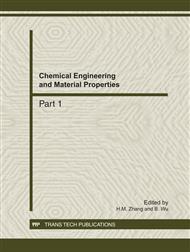p.1423
p.1427
p.1431
p.1435
p.1440
p.1445
p.1450
p.1455
p.1459
Investigation on the Co-Combustion Characteristics of Textile Dyeing Sludge and Sawdust
Abstract:
The combustion characteristics of textile dyeing sludge,sawdust and its blends at different proportions were studied by thermogravimetric analysis(TG-DTG) at different heating rates. The results showed that there existed four obviously temperature zones during the textile dyeing sludge combustion curves, which were corresponding to moisture's exhalation、two stages of devolatilizations and fixed carbon combustion. With the increasing of heating rates, the burning time was shorten and the combustion rate was faster of the textile dying sludge. DTG curve of the blends was more closed to that of the larger proportions. Comprehensive combustion characteristic index SN of the sludge-sawdust blends showed an uptrend, which demonstrated that higher volatility had better combustion characteristics.
Info:
Periodical:
Pages:
1440-1444
Citation:
Online since:
December 2011
Authors:
Price:
Сopyright:
© 2012 Trans Tech Publications Ltd. All Rights Reserved
Share:
Citation:


